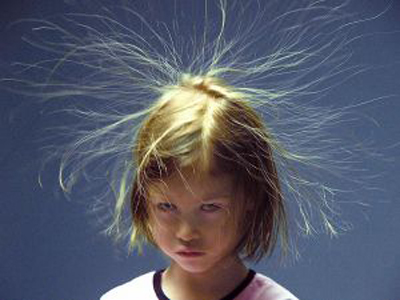7 Simple Questions with No Answers
Mundane mysteries

Ask a physicist about the radius of the black hole at the center of the galaxy and she'll tell you more than you wanted to know. Ask her how a bicycle works, and she'll shrug. It may surprise you to learn that scientists lack explanations for some of the simplest questions you might think to ask. Read on for a taste of the many seemingly mundane questions no know can answer.
Why do cats purr?

From house cats to cheetahs, most felid species produce a "purr-like" vocalization, according to University of California, Davis, veterinary professor Leslie Lyons. Domestic cats purr in a range of situations — while they nurse their kittens, when they are pet by humans, and even when they're stressed out. Yes, you read right: Cats purr both when they're happy and when they're miserable. That has made figuring out the function of purring an uphill struggle for scientists.
One possibility is that it promotes bone growth, Lyons explained in Scientific American. Purring contains sound frequencies within the 25- to 150-Hertz range, and sounds in this range have been shown to improve bone density and promote healing. Because cats conserve energy by sleeping for long periods of time, purring may be a low-energy mechanism to keep muscles and bones healthy without actually using them. However, this tentative theory doesn't explain why cats purr in the situations they do. "I am pretty sure this one will stay a mystery still cannot get cats to talk about it no matter how hard I try," Lyons told Life's Little Mysteries. [10 Facts For Cat Lovers]
How do bicycles work?

We've been riding them for about a century, all the while thinking someone out there had a handle on how, exactly, they worked. But as it turns out, no one did. And they still don't.
Bikes can stay upright all by themselves, as long as they're moving forward; it's because any time a moving bike starts to lean, its steering axis (the pole attached to the handlebars) turns the other way, tilting the bike upright again. This restorative effect was long believed to result from a law of physics called the conservation of angular momentum: When the bike wobbles, the axis perpendicular to its wheels' spinning direction threatens to change, and the bike self-corrects in order to "conserve" the direction of that axis. In other words, the bike is a gyroscope. Additionally, the "trail effect" was thought to help keep bikes stable: Because the steering axis hits the ground slightly in front of the ground contact point of the front wheel, the wheel is forced to trail the steering of the handlebars.
But recently, a group of engineers led by Andy Ruina of Cornell University upturned this theory of bicycle locomotion. Their investigation, detailed in a 2011 article in the journal Science, showed that neither gyroscopic nor trail effects were necessary for a bike to work. To prove it, the engineers built a custom bicycle which could take advantage of neither effect. The bike was designed so that each of its wheels rotated a second wheel above it in the opposite direction. That way, the spinning of the wheels canceled out and the bike's total angular momentum was zero, erasing the influence of gyroscopic effects on the bike's stability. The custom bike's ground contact point was also positioned in front of its steering axis, destroying the trail effect. And yet, the bike worked.
The engineers know why: they added masses to the bike in choice places to enable gravity to cause the bike to self-steer. But the work showed there are many effects that go into the stability of bicycles — including gyroscopic and trail effects in the case of bikes that have them — which interact in extremely complex ways.
"The complex interactions have not been worked out. My suspicion is that we will never come to grips with them, but I don't know that for sure," Ruina told Life's Little Mysteries.
Why does lightning happen?

We know why lightning strikes: It happens because positive electric charges build up near the tops of thunderclouds and negative charges build up at the bottoms. The electrical attraction between these opposite charges, and between the negative charges and positive charges that build up on the ground below, eventually grows strong enough to overcome the air's resistance to electrical flow. The charges suddenly shoot toward one another and connect, completing an electrical circuit and triggering a flash of "lightning" as charges shoot along the circuit they have formed.
But why do opposite charges build up in different parts of clouds? [Gallery of the Craziest Clouds]
It's a subject of great theoretical debate. One theory holds that when ice particles within a cloud collide, they tend to fracture into smaller particles with positive charge, and larger particles with negative charge. Gravity pulls the larger, negatively charged particles downward, and updrafts lift the smaller, positively charged particles upward, resulting in an imbalance. But measured values of electric fields in thunderclouds don't seem to match those scientists woudl expect to result from this process. Another theory holds that high-energy electrons delivered by cosmic rays from space shoot down through the cloud, stripping off more negatively charged electrons as they go and dragging them toward the bottom of the cloud, causing the charge imbalance. Which is the right explanation? The jury of lightning scientists is still out.
Why are moths drawn to lights?

"Look! That moth just flew straight into that lightbulb and died!" said no one ever. We see it happen so often that it's more likely to invoke yawns than discussion. But, surprisingly, the reason for these insects' suicidal nosedives remains a total mystery. Science's best guesses about why they do it aren't even very good.
Some entomologists believe moths zoom toward artificial light sources because the lights throw off their internal navigation systems. In a behavior called transverse orientation, some insects navigate by flying at a constant angle relative to a distant light source, such as the moon. But around man-made lights, such as a campfire or your porch light, the angle to the light source changes as a moth flies by. Jerry Powell, an entomologist at the University of California, Berkeley said the thinking is that moths "become dazzled by the light and are somehow attracted."
But this theory runs into two major stumbling blocks, Powell explained: First, campfires have been around for about 400,000 years. Wouldn't natural selection have killed off moths whose instinct tells them to go kamikaze every time they feel blinded by the light? Secondly, moths may not even use transverse navigation; more than half of the species don't even migrate.
Alternate theories are riddled with holes, too. For example, one holds that male moths are attracted to infrared light because it contains a few of the same light frequencies given off by female moths' pheromones, or sex hormones, which glow very faintly. In short, male moths could be drawn to candles under the false belief that the lights are females sending out sex signals. However, Powell points out that moths are more attracted to ultraviolet light than infrared light, and UV doesn't look a bit like glowing pheromones.
Moth deaths: not as yawn-inducing as you might think.
Why are there lefties (and righties)?

One-tenth of people have better motor dexterity using their left limbs than their right. No one knows why these lefties exist. And no one knows why righties exist either, for that matter. Why do people have just one hand with top-notch motor skills, instead of a double dose of dexterity?
One theory holds that handedness results from having more intricate wiring on the side of the brain involved in speech (which also requires fine motor skills). Because the speech center usually sits in the brain's left hemisphere — the side wired to the right side of the body — the right hand ends up dominant in most people. As for why the speech center usually (but not always) ends up in the left side of the brain, that's still an open question.
The theory about the speech center controlling handedness gets a big blow from the fact that not all right-handed people control speech in the left hemisphere, while only half of lefties do. So, what explains those lefties whose speech centers reside in the left sides of their brains? It's all very perplexing.
Why is yawning contagious?

Last year, Austrian researchers won an Ig Nobel Prize for their discovery that yawns are not contagious among red-footed tortoises. [Ig Nobel Prize Winners Make Hilarious Contributions to Science]
We know so much about tortoises, but human yawning? Still an enigma. The sight of a person's gaping jaws, squinting eyes and deep inhalation "hijacks your body and induces you to replicate the observed behavior," writes the University of Maryland, Baltimore County, psychologist Robert Provine in his new book, "Curious Behavior" (Belknap Press, 2012). But why?
Preliminary brain-scan data indicate that regions of the brain associated with theory of mind (the ability to attribute mental states and feelings to oneself and others) and self-processing become active when people observe other people yawning. Many autistic and schizophrenic people do not exhibit this brain activity, and they do not "catch" yawns. These clues suggest contagious yawning reflects an ability to empathize and form normal emotional ties with others, Provine explained.
But why should our social connections with one another circulate through yawning, as opposed to hiccupping or passing gas? No one knows for sure, and that's because no one knows quite why we yawn. Embryos do it to sculpt the hinge of their jaws. Fully formed people do it when we're sleepy and bored. But how does yawning ameliorate these complaints?
What causes static electricity?

Static shocks are as mysterious as they are unpleasant. What we know is this: They occur when an excess of either positive or negative charge builds up on the surface of your body, discharging when you touch something and leaving you neutralized. Alternatively, they can occur when static electricity builds up on something else — a doorknob, say — which you then touch. In that case, you are the excess charge's exit route.
But why all the buildup? It's unclear. The traditional explanation says that when two objects rub together, friction knocks the electrons off the atoms in one of the objects, and these then move onto the second, leaving the first object with an excess of positively charged atoms and giving the second an excess of negative electrons. Both objects (your hair and a wool hat, say) will then be statically charged. But why do electrons flow from one object to the other, instead of moving in both directions?
This has never been satisfactorily explained, and a study by Northwestern University researcher Bartosz Grzybowski found reason to doubt the whole story. As detailed last year in the journal Science, Grzybowski found that patches of both excess positive and excess negative charge exist on statically charged objects. He also found that entire molecules seemed to migrate between objects as they are rubbed together, not just electrons. What generates this mosaic of charges and migration of material has yet to be determined, but clearly, the explanation of static is changing.
Sign up for the Live Science daily newsletter now
Get the world’s most fascinating discoveries delivered straight to your inbox.
Natalie Wolchover was a staff writer for Live Science from 2010 to 2012 and is currently a senior physics writer and editor for Quanta Magazine. She holds a bachelor's degree in physics from Tufts University and has studied physics at the University of California, Berkeley. Along with the staff of Quanta, Wolchover won the 2022 Pulitzer Prize for explanatory writing for her work on the building of the James Webb Space Telescope. Her work has also appeared in the The Best American Science and Nature Writing and The Best Writing on Mathematics, Nature, The New Yorker and Popular Science. She was the 2016 winner of the Evert Clark/Seth Payne Award, an annual prize for young science journalists, as well as the winner of the 2017 Science Communication Award for the American Institute of Physics.











